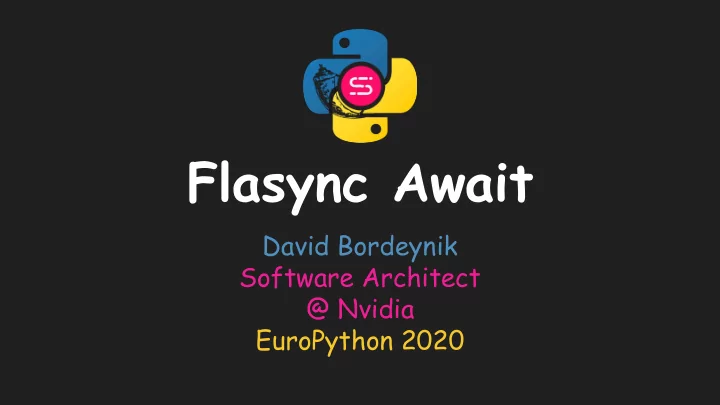

Flasync Await David Bordeynik Software Architect @ Nvidia EuroPython 2020
Setting up expectations This session IS a mind opener on how to provide added value with minimal ● effort. This session IS NOT about saying X is a bad technology and Y is a good ● technology. Assuming knowledge in web development and REST APIs in particular. ●
Motivation 3-4x
Motivation - cont. 3-4x
Notes on the motivation experiment simplejson is installed as an optional dependency for flask. ● ab is used for benchmarking. ●
Flask A micro web framework that revolutionized how web is developed with python.
Asyncio Library to write concurrent IO-bound* code using the async/await syntax. * Example for IO-bound: http requests ; example for CPU-bound: compression.
Asyncio - cont. Why asyncio? what’s wrong with thread / process per request? Currently, we consume more HTTP based services than ever. => We easily reach 10k connections concurrently on a single server (AKA c10k problem). => cooperative tasks that can better utilize a CPU can save a lot of $$$.
Sanic Python 3.6+ web server & web framework that’s written to go fast using the async/await syntax.
Introducing pyaday CRUD for python packages metadata used by content curators. ● Get your daily random python package metadata for fun and profit. ●
Introducing pyaday - cont.
Introducing pyaday - cont. TODO: examples
Introducing pyaday - cont. TODO: examples
Introducing pyaday - cont.
Introducing pyaday - cont. TODO: examples
Introducing pyaday - cont. TODO: examples
Introducing pyaday - cont.
Introducing pyaday - cont. TODO: examples
Why convert? Better bang for the buck for a large scale expensive cloud deployment or a limited in resources on premises deployment. => Meaning - it will save you $$$ In addition, we’ll try to show the migration is not difficult and the flask knowledge is not wasted.
Let the conversion begin! Prerequisite: A project that can benefit from conversion written in python3.6-3.8 (I used 3.8.3). $ poetry init #not mandatory, my preference $ poetry add sanic * Flask v1.1.2 & Sanic v20.3.0 were used, so syntax may vary on different versions.
App constructor
Route On Flask request object is globally imported ; on Sanic it is the first arg. ● On Sanic, the route is a coroutine (a function that uses the async ● keyword).
JSON response Happy path:
JSON response - cont. Error handling (according to RFC7807): * There are other Flask options: response = jsonify(title=”...”) response.status =... return response
Auto reload for development Same for Flask & Sanic* * There are other options as well: - Flask, from terminal: FLASK_ENV=development FLASK_APP=main_flask.py flask run - Sanic: app.run(auto_reload=true)
Blueprint * Used for sub-routing => contains all the exposed methods of a certain route. * Sanic does not require import_name.
Blueprint - cont. * register_blueprint can work as well in Sanic, but it is marked as deprecated.
Post conversion diff
Post conversion diff - cont.
Post conversion diff - cont.
Post conversion diff - cont.
Post conversion diff - cont.
Testing * Test client: Flask through a method and a context manager ; Sanic - through an attribute. * Calling routes: Flask - returns `response` ; Sanic - returns `request` & `response`. * Check response status: Flask - `status_code` ; Sanic - `status`.
Testing Diff
Testing Diff - cont. Sanic tests can also be async (pytest-sanic package is a requirement for this):
Testing Diff - cont. * There is only one return value - response, similar to Flask. * Need to “await” every server call as opposed to Flask.
Deployment
Deployment - cont. 5-6x for GET /rand route
Not always a fairytale A cognitive bourdain: for a performant (and an effective) async code the ● event loop must never be blocked: IO should be await(ed) ○ CPU should run elsewhere (loop.run_in_executor(...)) ○ Sanic’s ecosystem is not as rich as Flask’s ecosystem. It is noticeable on ● Github, on the number of available tutorials and on 3rd party integrations (like okta, auth0 or swagger-codegen).
Not always a fairytale - cont. Need to use 3rd party libraries that do not block IO: ● psycopg2 -> asyncpg / aiopg* ○ requests -> httpx / aiohttp ○ redis -> aioredis / asyncio-redis ○ ... * That’s why a DB wasn’t used for the converted application - to make the comparison simple.
The async web framework landscape Sanic was chosen for this talk because: ● It is popular on Github ○ The API it exposes is very similar to the API exposed by Flask. When the API is not the ○ same, it seems like a reasonable evolution that’s made possible because there isn’t a lot of backward compatibility needed. It is backed by a community run organization. ○ 90s flashback :) ○ Quart is also a Flask like async web framework. ● Fastapi is a hybrid web framework (sync and an async) with dependency ● injection as a guiding principle.
Summary When a Flask app that mostly performs IO becomes ● resource hungry, it is worthwhile to convert it to Sanic in reasonable effort. After converting, the code must be IO & CPU aware in ● order to not block the event loop.
@DavidBordeynik
Recommend
More recommend